Painter, poet and philosopher Paul Hartal is interviewed by Gil Dekel.
Gil Dekel: What is your view on the sources of creativity in art? [1]
Paul Hartal: Creativity is a cognitive process that results in new outcomes. It generates original ideas and novel products. Since creative faculties are not distributed evenly at birth, we come to the world with significant differences in levels of intelligence and talent orientation. [2]
Art happens in a culture, in a society and under certain historical conditions. Formal and informal education plays a significant role in the development of the artist. It is possible to hone talent and to stimulate inventiveness. But creativity can be taught only to a certain extent. [3]
A significant aspect of the arts concerns the hilarious and the amusing. Humour opens an intriguing door to wisdom. Another major source of creativity originates in the irrational realm of dreams and the unconscious. [4]
I think that all art disciplines share common traits with each other. Poetry, painting, music, dance, drama and film involve parallel creative processes. They may express similar content and vision in different forms. Each art form communicates meanings through its own specific set of symbols. At the same time the sources of creativity transcend the individual. Thus, poetry, music, painting and all the arts, flow from the same external fountainhead of creativity. [5]
What is that external creative fountainhead? Or, may I ask, what is inspiration? [7]
I believe that our intuitions, imagination, emotions, ideas, memories, thoughts and dreams are not independent events of an autonomous brain and nervous system. We are an integral part of nature and cognitive processes occur in an organism sustained by its environment. They take place in a body that interacts with the biosphere and the entire universe. [8]
Inspiration literally denotes inhaling and refers to the ancient belief that artists breathe in supernatural spirits. Meaningful archetypal dreams surface through the personal unconscious, from the deepest layers of the psyche, what Jung calls the collective unconscious, as nocturnal images, memories and fantasies. [9]
But I would like to go beyond Jung. We live in a holographic world in which the whole contains the part and the part contains the whole. Accordingly, the metaphors of the human mind reflect the metaphoric universe and our creative impulse echoes the creativity of the cosmos. I envisage the existence of a universal field of consciousness which permeates the cosmos. Our own consciousness originates from this spectrum. Similarly to a television set that receives its programme from a broadcast station, our brain acts as a receiver of information transmitted by the stars and galaxies. [10]
The universe is a poet. Its symmetry entails reciprocity. Its holographic qualities imply that when poets write poems the universe writes its own. This follows from the unity of the knower and the known. The artist is part of the universe, and the universe is part of the artist. [11]
The idea of the primacy of consciousness is also supported by science. In the 1920s the astrophysicist Arthur Eddington suggested that the stuff of the world is “mind-stuff”, which does not spread out in space and time, but rather space and time are spun out of it. [12]
Among other renowned scientists John Wheeler also holds that what we experience as matter originates in the mind. The primacy of the mind involves cybernetics, because, in Wheeler’s view, the laws of physics can be stated in the language of information theory: “it from bit”. Also, more recently, the nuclear physicist Amit Goswami has advanced his credo that the universe is an unconscious entity, which becomes aware of itself through human consciousness. [13]
I believe that we can gain deeper insights about the true nature of the universe through our senses than through our intellect. This is so because the universe is made not only of mind-stuff but also of love-stuff. Love is built into the fabric of the cosmos. From a scientific perspective, love basically can be viewed as an attractive and binding force that exists throughout the universe, even at the atomic and molecular level. The stars and the galaxies, indeed infinite space itself, are an extension of the self, the external dimensions of our inner sphere. And they are imbued with love. We are created by the universe but we also create it. We are born to love and to be loved. Life and love are inexorably interwoven. Life exists as a result of love, and love exists as a result of life. In the beginning of time man and woman were not separated and they desire forever to return to this primordial state. It is in the transitory ecstasy of the embrace when man and woman reunite that the universe reveals a mysterious glimpse of its deepest secret. [14]
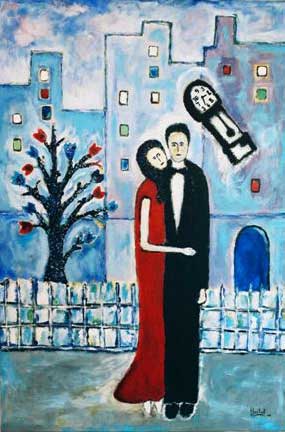
Figure 2: Time Does Not Exist: Love is Eternal (blue version), 2005, 91cm x 61cm approx, acrylic on canvas.
How does inspiration works upon you while you paint or write a poem? [16]
While I paint or write I focus on the work itself and do not reflect on theory. Inspiration itself, however, is just the beginning. According to an old maxim, art is ten percent inspiration and ninety percent perspiration. [17]
What inspires you to create? [18]
I see the world as a mysterious place, full of magic and wonder. Life is a precious gift, in spite of all its hardships and tragedies. It comes with potentials. Humans have the power of honouring and celebrating life, as well as trivializing and debasing it. I find inspiration in the excitement and the sorrow of existence, the beauty and ugliness of the world, in grand events and in trivial things. Some aspects in my oeuvre are influenced by ironic traits and humorous moods. [19]
I view myself as a Lycoist, or Lyrical Conceptualist. Lyco Art is a new idea, which I introduced into the periodic table of art with A Manifesto on Lyrical Conceptualism, published in Montreal in 1975. Lycoism is concerned with the creative process, cultural transformation and the human condition. It engages the entire scale of formative energies through transformative vision, a voyage of aesthetic consciousness in which passion evolves as logic and logic becomes passion. It expands the boundaries of aesthetics and identifies the meaning of art with its life serving purpose. [20]
In my vision paintings and poems are portals of the mind and the soul. Immersed in the artist’s vision, paintings arrest and frame the unrelenting chaos of the world. I believe that art must concern itself with science and technology because in our post-industrial society science and technology determine our lifestyle. At the same time, one of the major goals of art is the humanisation of the environment and therefore science and technology should not be our masters but our servants. Intuition and imagination play a salient role in both art and science. Transcending the state of existing conditions necessitates innovative leaps into uncharted areas. Consequently the cognitive faculty of creative imagination is more important in advancing the human condition than the inert body of knowledge. [21]
How would you define poetry? [22]
The word poetry derives from the Greek poesis, which means making and creating. Literary tradition describes poetry as an artistic form that conveys meanings through the aesthetic and evocative qualities of language. [23]
Poetry pleases, moves and elevates by word choice and word form, the interaction of style, pattern, sound, image and idea. Great poetry expresses heightened thought, intensified emotion, concentrated observation and soaring imagination. [24]
The towering construct of the poetic diction rises as a memorable experience wrapped and ornamented in such artistic devices as simile, metaphor, rhythm, rhyme, alliteration, onomatopoeia and melody. [25]
Poetry extends beyond language. And in the final analysis it eludes exact definition. I read somewhere that poetry is the frame of life. I think it is rather the other way around: Life is the frame of poetry. Let me go even further: Life is identical with poetry. [26]
Why do you create art? [27]
Why indeed? Would it not be easier to live without art? I think it would be simpler but not easier. Could I live without creating art? I believe I could; but it would be a grey and attenuated life. So, the answer to your question is that I paint pictures and write poems because they make my life more interesting, more exciting and more meaningful. [28]
However, your question also opens a Pandora’s box of unsolved mysteries and enigmas. What is art? It defies universal definition. Aesthetic philosophies depend on context and history. Creating art is a cultured instinct propelled by the atavistic memory of star formations, butterfly colours and bird songs. Art is an impulsive thrust, a spontaneous wave of excitation. Also, creating art is a therapeutic experience. Art heals. As a way of meditation it not only purifies the soul, but in terms of body-mind interaction art is also capable of enhancing the immune system by psycho-neurological stimulation. Among its many potential roles, art has important transformative capacities as a formidable humanising force. Moreover, art can also function as an effective weapon of social criticism. [30]
You talked about the unity of word and image, but what is the difference between the two? [31]
Word and image resist conversion. They mutually defy transference into each other. Thus, the main underlying difference between poetry and painting stems from their medium specificities. The visible properties of the world comprise the essential subjects of painting. A painting is a frozen picture in time, presented on a two-dimensional surface. Poetry on the other hand is a verbal composition, an emotional or mental event moving through linear time. Reading a poem is a linear experience progressing through time. Its length can be measured by the clock. However, the duration of viewing a painting is not a time-determined linear experience. [32]
A poem consists of words soaring through the vibrating air as sounds, or written in the abstract symbols of text. A painting on the other hand is a two-dimensional image of the three-dimensional world in visual form and colour. How one is supposed to capture on the canvas the sound of “O”, or the sound of a conjugated verb? And then there are feelings, emotions, and sensations, nuances of meaning and abstract concepts. These cannot be expressed by means of figurative realism. Perhaps, a great artist might succeed in expressing them through symbolic compositions, but not without sacrificing clarity. [33]
All art forms are metaphorical, and ambiguity is built into their fabric and essence. Both poetry and painting are semiotic systems of signs and symbols that communicate messages. It also should be noted that the proverb, “a picture is worth ten thousand words”, is a reversible adage for a word can also be worth ten thousand pictures. So, words can describe pictures and pictures can illustrate words. They can complement, enhance and synergise each other, but they can never entirely replace each other. Painting is pictorial and visual, whereas poetry is verbal and auditory. [34]
You talked about life as a gift that people can choose to celebrate or debase. Do you think that all people have the opportunity to choose in life? Perhaps some people are born into a situation/place that they cannot change? [35]
Of course life is finite, a short visitation in transitory time. I take it for granted that reality is bigger than the individual. Besides, people are born indeed with different genetic givens, with different abilities and into different socio-economic conditions. Thus, talent alone is not enough. People who have to toil hard to make ends meet can hardly afford to get an appropriate education in order to realize their dreams. Nevertheless, exceptional individuals motivated by strong will and tenacious determination do succeed in spite of all hardships. And luck also can play a role in success. The world is a rather uncontrollable place and life is an unpredictable chess game. [36]
Historical and geographical conditions have their say, too. If you live under the rule of the Khmer Rouge, or the Taliban, you cannot become an artist in the Western sense. Now, after all this clarification, the main point regarding the possibilities of celebrating or debasing life remains intact. We have the historical evidence that humans even under the most dreadful conditions are capable of retaining their lofty spirit and inner dignity. The individual has the inward potential to rise above his or her own suffering and to turn it into a moral triumph of integrity. [37]
Do you think artists make a choice (conscious or subconscious), regarding which art form they will engage with? [38]
I think that artists are aware of their specific talents before they become accomplished practitioners. It is not a coincidence that Rembrandt and Picasso were painters and not musicians. [39]
Your academic background varies from science and medical studies, to geography, history, education and art. Are there similarities, or a core essence, in the teachings of these fields? [41]
The achievements of science and technology are truly astonishing but they have been accomplished with the help of the arts. Science and art complement each other. Just think of such ubiquitous elements of daily life as writing, printing, photography, film, television, computer design and the architecture of the city. They would not be available to us without the creative mind of the artists. [42]
The stars of Newton and Hawking are not closer to reality than the stars of Goya or van Gogh. In its strife for discovering how the world actually is, science does not discover how real is real. Instead, it discovers what it can say about nature in human language (which includes mathematics). [43]
Even mathematics, the most exact subject on earth and the queen of sciences is a construct of the human mind. It is much less rational than it pretends to be. For example, mathematics inconsistently allows multiplying by zero but forbids dividing by zero. So the realm of the queen of sciences is a wondrous kingdom, floating on the lake of poetic ideas, such as the hierarchy of infinite sets or the baffling imaginary number i (the evasive square root of minus one). Consequently, in the words of Albert Einstein: “as far as the propositions of mathematics refer to reality, they are not certain; and as far as they are certain, they do not refer to reality”. [44]
It is a common myth that scientists test their theories against exact observations and proceed in accordance with the precise rules of irrefutable logic. However, scientific creativity, similarly to artistic creativity, incorporates irrational components. The physicist, as Einstein points out, cannot arrive at the principal universal laws of the cosmos by pure deduction: “There is no logical path to these laws; only intuition, resting on sympathetic understanding of experience, can reach them”. [45]
I believe that art and science are symbolic endeavours through which humanity explores, structures and interprets reality. There is art in science and science in art. On the whole, it is true though that compared to the rational and objective methods of science, art offers an irrational and subjective approach. Nevertheless, art is completely concrete, and therefore a significant source of authentic empirical knowledge. In certain respects, this form of concrete knowledge challenges the epistemological status of the mathematical abstractions of science because genuine knowledge can be only achieved by the experience of the senses, and art is based on sensory realization. [46]
I mentioned above that an important facet of the arts involves the hilarious and the amusing. Since ancient times people were aware of the healing power of laughter. “A cheerful heart is good medicine”, says the Book of Proverbs (17:22). However, for scientists hearsay is not enough. So let me mention that a recent pioneering study at the University of Maryland, for example, has found cardiologic evidence that laughter indeed benefits the heart and improves the healthy function of blood vessels. [48]
Nowadays psychologists, neurologists and immunologists take an increased interest not only in humour but also in poetry, literature, music, painting, dance, theatre and film, because all the arts have potential healing qualities. Integrative medicine treats the whole person, not only a specific organ. It recognizes that the human organism has an inner healer and it significantly influenced by the mind. A positive, optimistic mind set is a prerequisite of well being. [49]
A strong scientific basis for the integration of the arts into medicine is found in interdisciplinary studies. Since the 1970s the new interdisciplinary science of psychoneuroimmunology (PNI) is making inroads in furthering our knowledge on the function of the brain and the immune system as an integrated system of defence. Candace Pert in her book of 1997, Molecules of Emotion, shows that our thoughts and emotions are deeply interdependent in our bodies with a chemical information network of neuropeptides. Due to the presence of the neuropeptides on both the walls of the brain and the immune system, thoughts and emotions occur throughout the entire body. Through the mobile brain of these molecules the mind becomes body and the body becomes mind. [50]
Intrigued by dramatic claims for mental control over involuntary bodily functions through the ancient meditative practice of Yoga and Zen Buddhism, Herbert Benson at Harvard Medical School decided one day to test whether the rumours were true or not. His research affirms that simple techniques of breathing and mind-focusing through meditation can in fact alter involuntary physiological functions. Thinking relaxing thoughts, concentrating on pleasant things and freeing the mind from worries have the capability of calming the overactive sympathetic nervous system. A part of the autonomic nervous system, the sympathetic nervous system regulates our involuntary behaviour. Meditation relaxes, alleviates stress and offers an efficient, safe and drugless therapy. [51]
I think we need a new and inclusive form of culture in which art should play a more salient role. The justification for this stems from the inherent limitations of science, its increasing nihilistic impact on education, on society and the human condition, as against the immense potential benefits and greatly undervalued functions of art. We need the imagination, the insight, the intuition, the lateral reasoning, as well as the spiritual values and the human norms that are excluded from the exacting, strict and inelastic methodology of science, but are inherent qualities of art. [52]
Science cannot answer teleological questions, such as why does nature exist, what is the final purpose of the universe, or what is the ultimate meaning of life. [53]
Moreover, science has no built-in moral values of right and wrong. On the other hand, a pivotal function of art is to serve as an ethical guide and moral compass to humanity. [54]
15 June 2008.
Images © Paul Hartal, Text © Paul Hartal and Gil Dekel. Gil Dekel holds exclusive international license to publish the interview in all Formats. Permission to republish or reproduce should be sought from Gil Dekel.
Interview conducted via email correspondence (Feb 2007, and May/June 2008).
Paul Hartal is based in Canada. Gil Dekel is based in the UK.

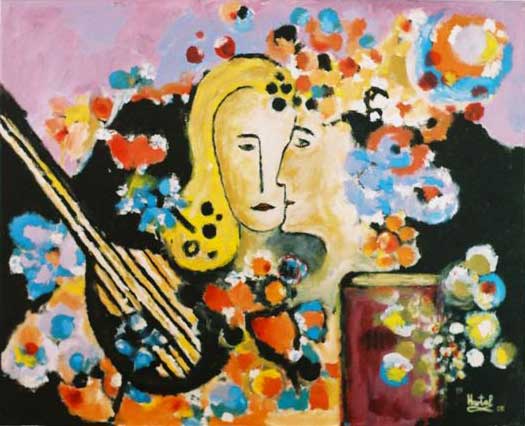
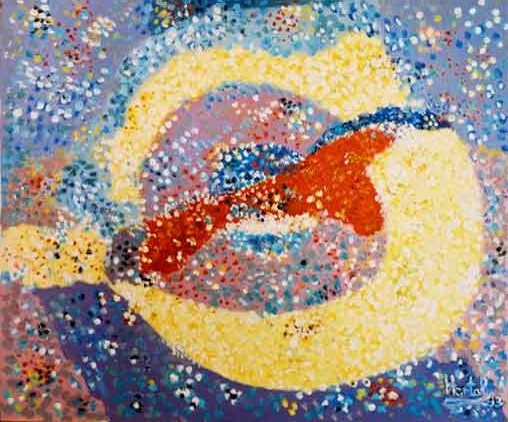
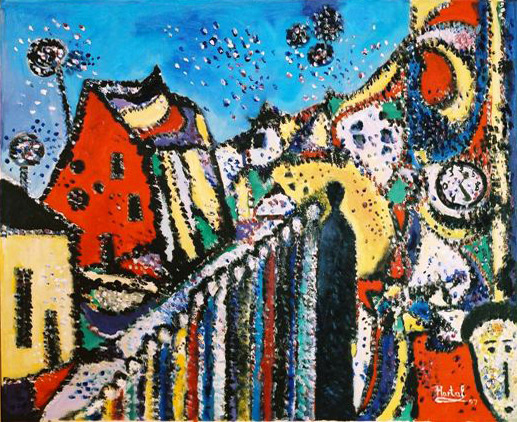
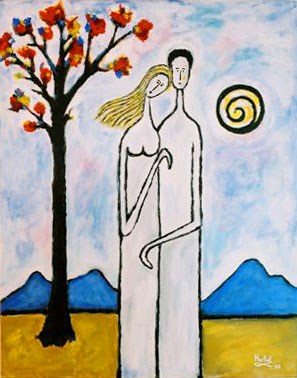
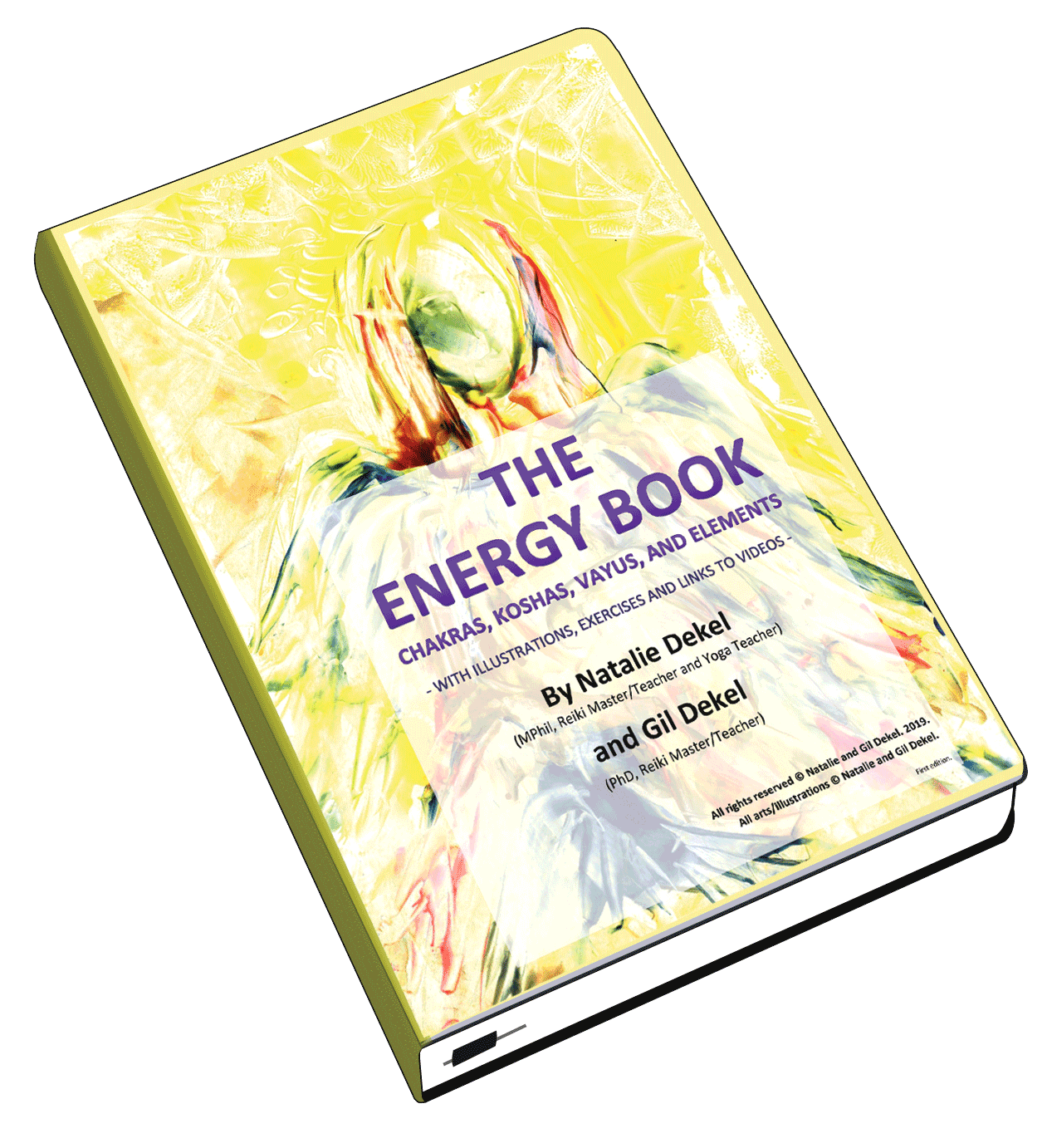
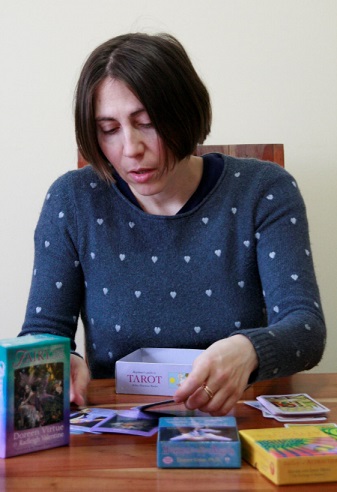 - Reading with Natalie, book here...
- Reading with Natalie, book here...